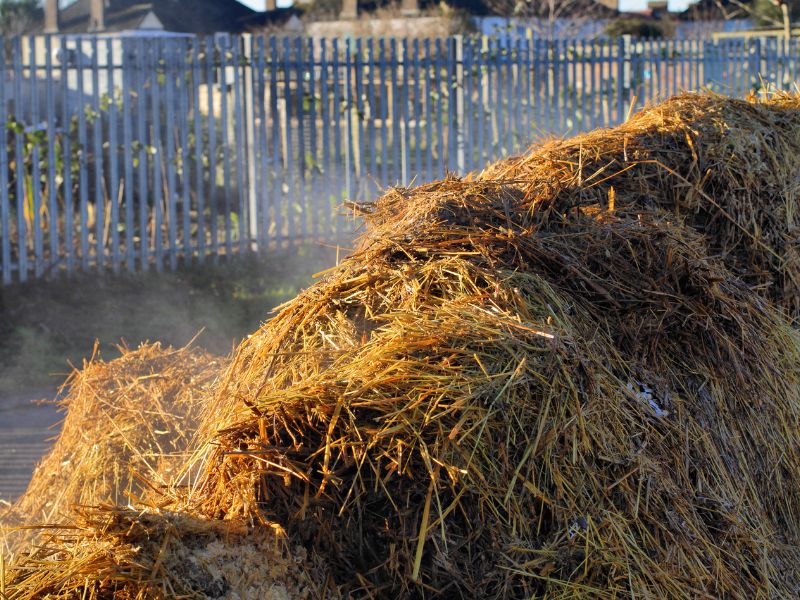5 Ways to Heat Up Your Compost Pile

Want to get finished compost faster? You may want to try increasing the internal temperature of your backyard bin! Contrary to popular belief, compost piles do not heat up or drop in temperature due to atmospheric conditions (i.e. sun exposure, warm weather or cold weather) but rather, as a result of heat generation by specialized bacterial populations.
Increased bacterial population density means faster decomposition due to more rapid consumption of nitrogen, carbon, moisture, and oxygen. This intensive resource consumption correlates to rapid fluctuations in bacterial population size and variety. This means that a pile is only hot for a finite period of time: temperature spikes will rarely last for more than a week, and peak temperatures are unlikely to be sustained for more than a few days.
Many composters will try and achieve multiple temperature spikes over several months, helping to neutralize any pernicious weed seeds amongst the pile, and producing finished compost in a shorter period of time.
While by no means an exhaustive explanation of the hot composting process, the following are some tips to experiment with creating some heat in your backyard bin!
Increase Volume
The greater the volume of materials (i.e. the more space and resources for bacteria to colonize and consume) the more likely the pile is to generate heat. Filling a bin full of material at the start or topping off a pre-existing pile will do the trick. Increasing the volume of compostables naturally increases the size of the pile core, where temperatures will be the hottest.
Note: It is possible to produce hot compost in small volumes, but requires a greater dedication to creating an optimal balance of inputs (i.e. calculating individual C:N ratios) and to habitual and responsive pile monitoring (i.e. ensuring consistent, even moisture content).
Increase Nitrogen
Adding nitrogen-rich ingredients like coffee provides “protein” for the bacterial communities, and will activate speedier decomposition processes in the bin. If adding a blast of nitrogen, aim to turn your compost to distribute the resource more evenly throughout the pile.
Maintain Moisture
Monitoring moisture levels to ensure even dampness is a surefire way to speed up decomposition (ideally, moisture content throughout the pile should be comparable to a wrung-out sponge). Other tips to retain moisture in the pile include keeping your bin in a shady location (slows dehydration from sun exposure) and keeping a layer of browns (i.e. burlap, pine needles) on the top of the pile.
Strategic Aeration
It is important to keep your pile aerated to provide enough resources for bacteria to thrive; however, turning too frequently can cause the pile to dry out. Timing turning with falling internal temperatures will re-generate heat in the pile, so responsive aeration is the best strategy to keep a pile consistently hot. Turning about once a week is a good rule of thumb.
Watch Your Thermometer
When it comes to composting, “the hotter the better” does not always apply. A pile is considered ‘hot’ when it reaches between 130°F -140°F. Beyond 150°F, beneficial bacteria will begin to die off in large numbers, and efficient decomposition may be compromised.
In order to determine if you are successfully generating heat, dig into the core of the pile to check for warmth (you might even see some steam). If you are interested in quantitatively monitoring internal temperature spikes, purchase a long-stemmed compost thermometer. Studying changes in the pile can be lots of fun, and many composters know off-hand their “personal best” temperatures!
Microorganisms at work
Curious about what microorganisms are residing inside of the compost pile and what they’re up to? Let’s dig in:
- Psychrophiles arrive during the first stage of decomposition. They exist in the pile mainly between 55-70 degrees Fahrenheit (F). The psychrophiles start to digest the material and release carbon dioxide, water and heat. This heat causes the pile’s temperature rise which attracts the mesophiles.
- Mesophiles thrive between 70 and 90 degrees F. The majority of the decomposition in your pile is performed by these microorganisms.
- Thermophiles will be found in your compost pile when the temperature rises above 104 degrees F. These temperatures will kill off almost all harmful organisms and weed seeds that may reside in your pile.
If a compost pile rises in temperature, it is an indication that the composting process is going well. When the thermophiles run out of things to eat, the temperature will steadily drop. This is a good time to turn your bin, add water, and add more nitrogen-rich green material into the center of your pile. The addition of material that is nitrogen-rich, like coffee, manure, or fresh cut grass, will heat your pile right back up as the thermophiles go to work.
Compost thermometers are great ways to tell which stage of decomposition your compost pile is at. These can be purchased in our online shop. Wishing you all good luck and speedy decomposition!
